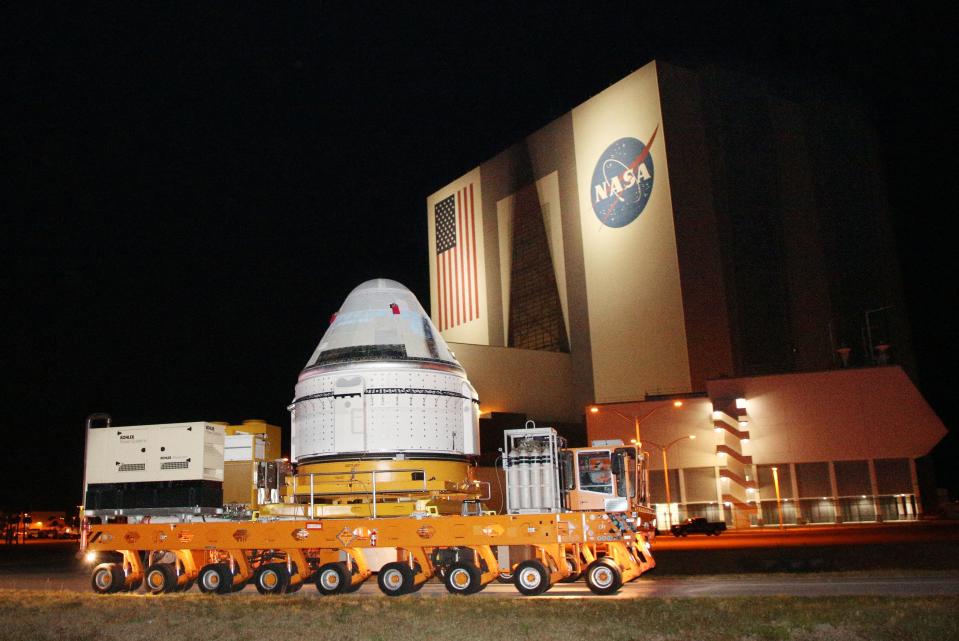Boeing's Starliner mission was scrubbed Monday. Here's when it will try to launch again.
Boeing's Starliner will have to wait just a little while longer until the space capsule finally transports its first crew into orbit.
The Atlas 5 rocket that would have carried the CST-100 Starliner, along with two NASA astronauts, into space was fueled and ready for takeoff Monday night before the mission was scrubbed at the last minute. The United Launch Alliance, which manufactured the rocket, said in a statement that the cancellation was "out of an abundance of caution for the safety of the flight and pad crew."
Trouble with a valve in the rocket's upper stage prompted engineers to make the call to delay the long-awaited launch – a critical demonstration of Boeing's spacecraft as it seeks to win approval from NASA to make routine orbital trips on the space agency's behalf.
NASA is now eyeing a May 17 launch date after the United Launch Alliance initially said that the launch would not be able to take place any earlier than Friday. Mission engineers requested the delay in order to have time to replace a pressure regulation valve on the rocket's liquid oxygen tank, NASA said Tuesday.
The planned launch would send two veteran NASA astronauts to the International Space Station for about a week before they ride the capsule back to Earth.
Horsehead Nebula: New photos from NASA's Webb telescope shows iconic 'mane' in stunning detail
Why was the Starliner launch scrubbed?
Monday's launch would have been the third and final orbital flight test for Boeing's Starliner before it could be approved to make routine trips to space for NASA.
But about two hours before the capsule perched atop an Atlas V rocket built by United Launch Alliance could liftoff from the Kennedy Space Station, mission managers scrubbed the flight. The United Launch Alliance said the decision came after an anomaly was detected on the pressure regulation valve in the liquid oxygen tank of the rocket's upper stage.
Today's #Starliner launch is scrubbed as teams evaluate an oxygen relief valve on the Centaur Stage on the Atlas V. Our astronauts have exited Starliner and will return to crew quarters. For updates, watch our live coverage: https://t.co/plfuHQtv4l
— NASA (@NASA) May 7, 2024
NASA and Boeing also confirmed the postponement. The two-person crew of Barry "Butch" Wilmore and Sunita "Suni" Williams safely exited Starliner and returned to their quarters, Boeing said on its website.
"The team needs additional time to complete a full assessment," the United Launch Alliance said in a statement.
When will the Boeing Starliner launch now?
After the mission was canceled, the United Launch Alliance initially said that it would target another launch attempt no earlier than Friday.
However, engineers who have since analyzed the data to fully understand the issue have determined that more time is needed. Now, NASA is saying that the next attempt will take place no earlier than 6:16 p.m. May 17.
What is the Boeing Starliner?
The Starliner was designed to accommodate no more than seven passengers for missions to low-Earth orbit.
For NASA, the capsule is intended to carry four astronauts along with a mix of cargo and other scientific instruments to and from the International Space Station.
Williams, 58, and Wilmore, 61, were selected for the inaugural crewed flight of the Starliner, which completed two previous flight tests with no one aboard. Both astronauts are Navy veterans who have each ventured to space twice before.
Once the Starliner launches and reaches the space station, the astronauts are scheduled to spend a little more than a week testing the spacecraft and its subsystems before they board the capsule for a return trip to Earth. The craft will land in the American Southwest using parachutes that will slow it down to 4 mph before inflating large airbags.
Why is NASA contracting with Boeing?
Boeing hopes to join Elon Musk's SpaceX as one of two companies contracted by NASA for routine missions to the space station and low-Earth orbit.
As part of NASA’s commercial crew program, Boeing was awarded $4.8 billion and SpaceX was awarded $3.1 billion in 2014 to develop their respective spacecraft, Florida Today reported.

Under NASA's more ambitious commercial lunar program, it's also paid SpaceX $2.9 billion to develop the first commercial human lander for the agency's Artemis moon missions and eventually trips to Mars.
SpaceX, whose Dragon spacecraft flew its first human mission in 2020, recently saw its Crew-7 return to Earth after nearly 200 days aboard the International Space Station. The eighth crew comprised of three NASA astronauts and one cosmonaut launched on March 3 and docked on March 5 to await the arrival of Boeing's Starliner capsule.
If the mission is a success, NASA will begin the final process of certifying Starliner and its systems for crewed rotation missions to the space station, according to NASA.
Eric Lagatta covers breaking and trending news for USA TODAY. Reach him at [email protected]
This article originally appeared on USA TODAY: When will Boeing Starliner launch? What we know after mission scrubbed
